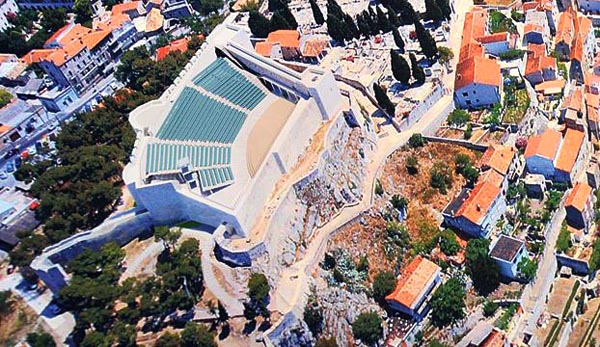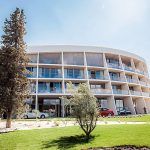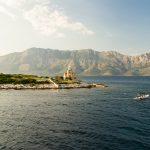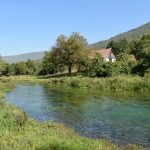Four historical fortresses will be the centre of Šibenik’s branding strategy
Implementation of a very costly and demanding revitalization project of all 4 historic forts in Šibenik reached the halfway mark while the most demanding part of the entire project is coming up next, Poslovni dnevnik reports on March 7, 2016.
Šibenik’s grand defense fortresses represent the pillars of the city’s future branding strategy and they will carry most of the weight in terms of new tourism services and facilities. After the full reconstruction of St. Michael’s Fortress and the recent opening of the equally impressive Barone Fortress, Šibenik is now working full steam ahead on the reconstruction of the most complex fortresses – St. John’s and St. Nicholas’, both located on small islets in front of the city. Reconstruction includes carefully devised programmes and auxiliary services that make every visit a very memorable experience, but most importantly, this pedantic approach shows that a city can take charge and control its own branding without waiting for somebody else to do it for them and making sure it is heading in the right direction.

Dozens of millions of euros are needed for these extremely complex and sensitive reconstructions and for the implementation of modern facilities for tourists, and this city knows only too well just how important European Funds are for this project. So far, most of the reconstruction costs of the first two fortresses were covered by EU funds, and the same will most probably happen with the last two, considering that Šibenik has an excellent team from which most Croatian cities could stand to learn a thing or two.
All fortresses will represent a fantastic fusion of modern technology and fascinating history, giving tourists an exceptional cultural and gastronomic experience. For instance, Barone fortress offers a stunning restaurant with a menu comprised of autochthonous dishes, carefully selected by one of Croatia’s most renowned chefs Zdravko Tomšić, and its own brand of souvenirs “Barone memories”. All tourists can go back in time and explore the vast history of the city and fortress using a fully digitalized smart table with loads of digital content and a full-length documentary. Augmented reality platform is also used in order to entice user experience and to enable visitors to immerse themselves in the story using their smartphones, tablets or available AR glasses.
“When they rent our AR glasses, visitors will be able to take the tour of the fortress with our digital guides – a boy named Jure and a renowned 17th-century historian Frane Divnić” – Tourist Board representative says.
While St. Michael’s fortress includes a full-size amphitheatre, Barone fortress has a smaller amphitheatre for events and concerts. The amphitheatre presents an ideal location for open air classes for students, interactive lectures and interactive cooking workshops: “The main aim of the Barone fortress project was to utilize the rich history of Šibenik, conveying the knowledge of our heritage, tradition and local identity in a modern way, using state of the art technology that, for the first time in Croatia, allows us to make history come to life” Tourist Board representative explains. “

The first fortress in Šibenik to be reconstructed in this extensive project, St. Michael’s fortress, quickly became one of the must-see sites and a great venue for concert organizers:
“With this project, St. Michael’s fortress became both a recognizable symbol of our cultural heritage that is open daily for locals and tourists and one of the most prestigious concert stages in the region. We have already hosted numerous plays, concerts and other cultural events, and its unique beauty and location contributes to the image of Croatia and Šibenik as one of the most renowned cultural tourism destinations” Tourist Board representative adds. In less than 2 years since it opened, St. Michael’s fortress had more than 250 000 visitors and held 43 evening events with performances by more than 600 renowned Croatian and international artists.

“Reconstruction of our fortresses enables us to position Šibenik as a destination with cultural and historical attractions based on innovative solutions and a very successful merger of tradition and modern technology. A product which we have received with the reconstruction of our fortresses enables us to diversify the position of Šibenik in the tourism market and to be less seasonal as a destination”.
“Šibenik – Innovative Adriatic Experience” is the brand this city aims to achieve, and reconstruction of the last two fortresses is a monumental part of this branding strategy. Largest of the four, St. John’s fortress is next in line, and this project has also applied for EU funding. The city of Šibenik submitted almost 1600 pages of project documentation for this fortress to the Central agency for EU funds. This project is worth 50 million kunas, results of the tender should be revealed soon, but judging by their previous successes, we are sure they will receive the funds they applied for (85% of the total investment). The project is considerably more expensive than the first two reconstruction projects because this particular fortress is the largest one in the city, located 115m above the old town and built back in 1646. Reconstruction project includes a wide boardwalk, trip and jogging paths around the entire complex, café with a large terrace, KID’S LAB2, an interactive historical laboratory and a green maze.

St. Nicholas’ fortress will be the last one to undergo reconstruction because this Venetian fort was suggested for the inclusion on the UNESCO list of heritage sites. The procedure should be completed this year. This fortress is the most important part of Šibenik’s entire fortification system and it will definitely be one of the most attractive tourist sites. For years, it was closed for public and not maintained so this reconstruction, though it will not be as wide and thorough as the first three fortresses, partly due to it hopefully becoming a UNESCO world heritage site, will certainly bring it back to its former glory.
After the project is complete, Šibenik will be a benchmark for other cities in Croatia and the best example of how a city can utilize is historical heritage and make it a centre of its entire branding strategy.









